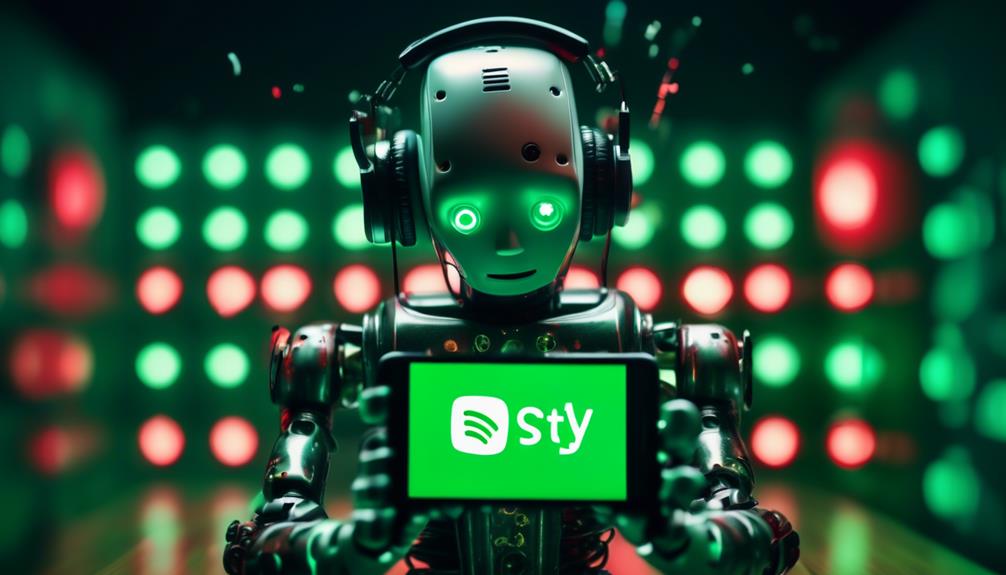
What is the Spotify bot policy?
Have you ever wondered what Spotify’s bot policy is? It’s a set of rules the company has in place to manage and regulate the use of automated applications, or bots, on its platform.
Often overlooked, these rules play a vital role in maintaining the integrity of the Spotify platform, ensuring fair play, and helping to create an enjoyable user experience.
But what exactly does Spotify’s bot policy entail, and why should you care? Let’s delve into the details to unravel the intricacies that underpin this important aspect of the world’s most popular music streaming service.
Key Takeaways
- Spotify bots are software applications that perform tasks on Spotify, but they can disrupt the user experience and violate Spotify’s terms of service.
- Spotify has strict terms and conditions in place to protect intellectual property rights, including copyright infringement and trademark breaches.
- Spotify prioritizes privacy and safety, with robust data encryption practices and strict control over access to user data.
Understanding Spotify Bots

To fully grasp the concept of Spotify bots, you must first understand their core functionality and role in the Spotify platform. Simply put, a Spotify bot is a software application programmed to perform certain tasks on Spotify, such as streaming songs, following accounts, or creating playlists. These tasks are usually repetitive and time-consuming, which is why bots are utilized.
Now, let’s delve into bot creation techniques. Creating a Spotify bot requires a combination of programming knowledge and an understanding of Spotify’s API. With these, a bot can be programmed to perform a variety of tasks, from simple song plays to complex playlist creation.
However, bots aren’t always beneficial. Some can disrupt the user experience or violate Spotify’s terms of service. This is where bot detection methods come in. Spotify employs sophisticated algorithms to identify and neutralize bots, ensuring a seamless user experience. These methods are continuously updated to combat innovative bot techniques.
Understanding Spotify bots, their creation techniques, and detection methods can provide invaluable insights into the innovative and ever-changing landscape of music streaming technology.
Spotify’s Terms and Conditions
You need to understand Spotify’s terms and conditions thoroughly.
This involves comprehending the user agreement, intellectual property rights, as well as privacy and safety policies.
These aspects are crucial in ensuring your interaction with Spotify and its bots is within the set guidelines.
Understanding User Agreement
Before diving into Spotify’s bot policy, it’s crucial to grasp their User Agreement, often referred to as the Terms and Conditions. The User Agreement interpretation can be complex; however, understanding the details can lead to better Agreement Compliance.
Here are some tips to help you navigate:
- Interpretation Tips
- Read every clause carefully.
- Seek professional advice if necessary.
- Compliance Tips
- Always adhere to the rules outlined.
- Keep yourself updated with any changes.
Intellectual Property Rights
Diving into Spotify’s Terms and Conditions, it’s essential to understand the section on ‘Intellectual Property Rights’, which outlines how the platform’s content can and can’t be used.
Spotify strictly prohibits copyright infringements and trademark breaches. This means you can’t use the service to copy, redistribute, or modify any part of the content without express permission. The content remains the sole property of Spotify or the respective copyright owner.
This includes not only music and podcasts but also the brand features and logos. If you violate these rules, your account could be suspended or terminated. Therefore, when using Spotify’s services, you must respect the intellectual property rights of all parties involved.
Privacy and Safety Policies
When it comes to your privacy and safety, Spotify’s Terms and Conditions lay out clear guidelines to ensure a secure user experience. Spotify’s commitment to innovation is reflected in its robust Data Encryption Practices and rigorous Personal Information Protection measures.
Spotify’s privacy and safety policies include:
- Data Encryption Practices
- Spotify uses state-of-the-art encryption to protect your data during transmission.
- Your data is stored securely, with access strictly controlled.
- Personal Information Protection
- Spotify collects only necessary data and uses it solely for service improvement.
- You have the right to access, correct, or delete your personal information at any time.
Spotify Bot Policy Explained
Understanding Spotify’s bot policy is crucial as it outlines the platform’s rules and regulations regarding the use of automated software. You must be aware of bot creation techniques and Spotify API limitations to innovate effectively and responsibly within their framework.
Spotify’s policy strictly prohibits the use of bots that manipulate streaming activity or infringe on user privacy. This includes bots designed to increase the number of streams or followers for a specific artist or track. You’re also not allowed to use bots for data scraping or unauthorized data collection from Spotify’s platform.
The limitations on Spotify’s API are in place to ensure fair use and protect the platforms’ integrity. You can’t exceed the API rate limits or use it for commercial purposes without Spotify’s express consent. Any violation of these rules can lead to API access suspension or even legal action.
In essence, Spotify’s bot policy encourages innovation but within a controlled environment that respects user privacy and fair play. It’s a balancing act between fostering creativity and maintaining a healthy, equitable ecosystem for all users and artists. Always remember, when innovating, it’s essential to respect the rules of the platform you’re using.
Implications of Violating Spotify’s Bot Policy

You might wonder what happens if you violate Spotify’s bot policy.
Let’s discuss the potential consequences of such a breach and how you can avoid misuse of bots.
Understanding these factors can help preserve your access to the platform and maintain a satisfactory user experience.
Policy Breach Consequences
If you violate Spotify’s bot policy, you’re subjecting yourself to a series of legal and account-related repercussions. User awareness is paramount: you must understand that any policy breach won’t be taken lightly.
- Legal repercussions:
- You may face legal action from Spotify or other third parties.
- Legal penalties may include fines or other sanctions.
- Account-related repercussions:
- Your account may be suspended or terminated.
- You might lose access to your playlists or saved music.
Innovation doesn’t mean breaking the rules. Therefore, respect Spotify’s bot policy to avoid these potential implications. Remember, it’s better to prevent a problem than deal with its consequences.
Preventing Bot Misuse
To steer clear of these severe consequences, it’s crucial to learn how to prevent bot misuse on Spotify. Understanding bot creation techniques and the potential botnet impacts can guide you in using Spotify responsibly.
Here’s a simplified guide:
| Techniques to Avoid | Why |
|---|---|
| Engaging in Bot Creation | This violates Spotify’s policy and can result in account suspension. |
| Participating in Botnets | Botnet impacts can be massive, damaging Spotify’s system and your reputation. |
The Purpose of Spotify’s Bot Policy
Spotify’s bot policy serves to safeguard the user experience by mitigating fraudulent activity and ensuring fair play on the platform. This policy enforcement is a testament to Spotify’s commitment to uphold the integrity of their platform and provide a seamless experience for all users.
The bot regulation serves two main purposes:
Firstly, it protects users from potential security threats. This includes, but isn’t limited to:
- Protecting the user’s personal data from being exploited.
- Preventing bots from manipulating the platform’s features and affecting the user’s experience.
Secondly, it maintains the fairness of the platform. This encompasses aspects such as:
- Ensuring fair competition among users, especially those who create and share content.
- Preventing any sort of manipulation that could lead to an unfair advantage or disadvantage for some users.
In essence, Spotify’s bot policy is an essential instrument in maintaining a safe, fair, and enjoyable platform for all its users. It’s a testament to Spotify’s innovative approach to user experience and security, always one step ahead in protecting you from potential risks and ensuring your experience remains unmarred by fraudulent activity.
How Spotify Detects Bots

Leveraging advanced algorithms and artificial intelligence, Spotify effectively identifies and mitigates bot activity on their platform. The system is designed to distinguish between real user behavior and bot-driven music promotion. It’s an innovative step towards ensuring a fair and balanced music streaming ecosystem.
Spotify’s bot identification techniques are sophisticated. They’re designed to detect unusual patterns in account activities, such as repetitive playlists and rapid-fire song playback. These signs could indicate a bot at work, manipulating play counts for particular tracks or artists. The system also identifies suspicious login activity, like multiple logins from different locations in quick succession.
When a potential bot is detected, Spotify takes action. They might limit the account’s activity or even suspend it altogether. They’re committed to maintaining the integrity of their platform and protecting artists, listeners, and the music industry at large.
Spotify’s advanced technology and stringent bot policy ensure that you, the user, enjoy a genuine music experience. It also guarantees that artists receive fair recognition for their work. So, while bots may try to game the system, Spotify is always a step ahead, using cutting-edge technology to keep the music playing fair and square.
The Impact of Bots on Spotify
While these advanced measures help to combat bot activity, it’s essential to understand the significant impact bots can have on Spotify’s music streaming environment. Bots, particularly those driving fraud, can drastically skew streaming data, resulting in inaccurate royalty payouts and misleading popularity metrics. This bot driven fraud could be detrimental to the platform’s credibility and reputation.
The impact of bots on Spotify can be categorized into two main areas:
- Impact on Artists and Industry
- Fraudulent streams can unfairly benefit certain artists, creating a sense of false popularity.
- Misallocation of royalty payments due to manipulated stream counts.
- Consumer Perception
- The credibility of Spotify’s charts and playlists could be questioned due to bot manipulation.
- Spotify users might lose trust in the platform due to perceived unfairness.
Therefore, the fight against bots isn’t just about maintaining a fair platform for artists, it’s about preserving your trust as a user, ensuring that the music you discover on Spotify is genuinely popular and not artificially boosted.
The Spotify Bot Policy is crucial to maintaining this balance, promoting innovation while protecting the integrity of the platform.
Reporting Bots on Spotify

If you suspect a bot is manipulating streams on Spotify, it’s important to know how to report it effectively. Bots can distort the streaming landscape, and Spotify relies heavily on users like you to help maintain the platform’s integrity.
Firstly, you need to familiarize yourself with bot identification techniques. Look for patterns that seem unnatural, like thousands of plays from a single account or constant streaming of a single track. These patterns can be red flags for bot activity. Additionally, if you notice an account with no profile picture, followers, or playlists, but with a high number of streams, it could be a bot.
Once you’ve identified a potential bot, report it directly to Spotify. You can do this through the app or website by providing the suspected bot’s username and any relevant details about the suspicious activity you’ve noticed.
Lastly, participate in Spotify’s User Awareness Campaign. By educating yourself and others about the impacts of bot activity, you can help create a more secure and fair streaming environment. Reporting bots isn’t just about maintaining the quality of Spotify—it’s about preserving the music ecosystem for artists and listeners alike.
Spotify’s Stance on Automated Playlists
Moving from the topic of reporting bots, it’s crucial to understand Spotify’s perspective on automated playlists. Spotify embraces innovation and automation, but the company also values the ethics behind playlist automation. They believe that the use of bots for music discovery can enhance user experience, but they also insist that these processes must respect and uphold the rights of artists and creators.
Spotify has implemented a few measures that showcase their stance on the subject:
- They’ve developed guidelines to govern playlist automation. These include:
- Ensuring fair compensation for artists
- Preventing manipulation of streaming numbers
- They’ve also dedicated resources to monitor and control bot generated music discovery. These measures include:
- Active detection and removal of malicious bots
- Encouraging user reporting of suspicious activities
How to Use Spotify Responsibly

In light of Spotify’s stance on bot usage, it’s essential that you understand how to use this music platform responsibly. Adhering to Spotify etiquette isn’t only about respecting the platform’s guidelines but also about fostering a better user experience for all.
Responsible streaming begins with understanding the impact of your actions. When you stream music, it’s not just about your personal enjoyment. It’s also about supporting the artists you love. By avoiding bots and focusing on organic interactions, you ensure that artists receive the recognition they deserve.
Remember that your playlists and shares can influence the music ecosystem. Therefore, curate your content thoughtfully, keeping in mind the ripple effects your choices can have.
Mind your privacy settings too. While sharing your music taste can create a sense of community, it’s important to balance openness with privacy.
Lastly, respect other users. Avoid spamming or harassing others. Just like in any social platform, being considerate and respectful goes a long way in enhancing the overall community experience.

